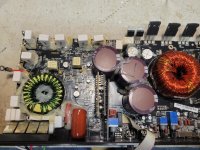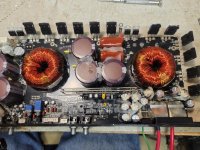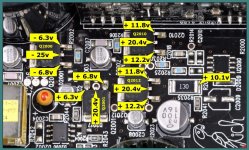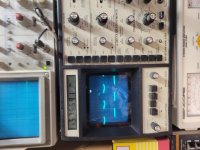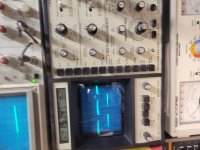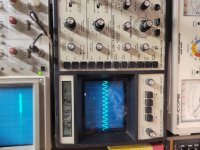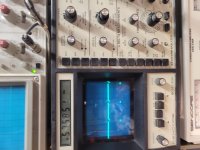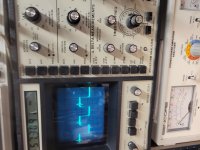Hi, working on a RF Power T2500-1bd. Power supply is running. No shorts in the outputs. I have +142V rail. I don't have the minus rail voltage. I have 160 AC to both negative rail diodes CR2 and CR1005 but +24 v on the cathodes. I pulled all the outputs just to make sure they weren't a problem. Anyone familiar with this amp that can give me some ideas. Called Rockford. Schematic not available.
Attachments
When you measured rail voltage did you measure between the middle legs of the rectifiers?
That’s how you test rail voltage in these amps
That’s how you test rail voltage in these amps
As was suggested above, you have to measure the rail voltage between the output legs of the rectifiers. There is no positive or negative rail. There is only one rail and it's switched up or down as needed for the output stage.
Just got back from vacation. Measured between diodes and have 137.4 volts. So I guess all that is fine. Now to find out why I have no output. I don't guess anyone has a schematic for this amp. Called Rockford they said not available for release yet.
Anyone familiar enough with this amp to answer a question for me. I think the amp is muted. I have what looks to be input on pins 2 and 4 of U2000 and U2002 but no output on pins 5 and 7. I have 6.8 volts on pin 8 of both chips. I believe this to be bd mute. I'm using a schematic for a Power T5001bd. Can't find where bd mute originates. Can anyone help?
On that diagram, U4-D is the mute output.
Do you have all of the various supply voltages?
Do you have audio reaching the output driver board?
Do you have rail-rail oscillation on the output transistors?
Do you have all of the various supply voltages?
Do you have audio reaching the output driver board?
Do you have rail-rail oscillation on the output transistors?
"On that diagram, U4-D is the mute output." Yes found it on the amp power supply driver board. U101
"Do you have all of the various supply voltages?" I have rail voltage. +/- 15 volts. The schematic shows regulators for various voltages. I don't see regulators on this board. So I don't know about the other voltages.
"Do you have audio reaching the output driver board?" Yes
"Do you have rail-rail oscillation on the output transistors?" Please explain how to check rail to rail oscillation with only one rail.
"Do you have all of the various supply voltages?" I have rail voltage. +/- 15 volts. The schematic shows regulators for various voltages. I don't see regulators on this board. So I don't know about the other voltages.
"Do you have audio reaching the output driver board?" Yes
"Do you have rail-rail oscillation on the output transistors?" Please explain how to check rail to rail oscillation with only one rail.
See attached for the regulators.
Do you see anything other than straight DC on any of the output transistors?
The Rockford amps are a bit different, compared to other class D amps but this is basically R-R oscillation:
bcae1.com - Car Amplifier Repair Tutorial - The Basics
Do you see anything other than straight DC on any of the output transistors?
The Rockford amps are a bit different, compared to other class D amps but this is basically R-R oscillation:
bcae1.com - Car Amplifier Repair Tutorial - The Basics
Attachments
Q2010 - B +11.18, C +13.55, E +11.75
Q2012 - B +11.18, C +13.64, E +11.76
Q2000 - B - 6.28, C -24.58, E -6.85
Q2001 - B +6.26, C +13.5, E +6.85
Pretty much straight DC on outputs.
No Rail to rail oscillation that I can see.
Q2012 - B +11.18, C +13.64, E +11.76
Q2000 - B - 6.28, C -24.58, E -6.85
Q2001 - B +6.26, C +13.5, E +6.85
Pretty much straight DC on outputs.
No Rail to rail oscillation that I can see.
How many high-frequency pulses (50kHz-100kHz) do you have on the header pins of the output driver board?
You don't need to drive a signal into the amp to get a drive signal.
Do you have drive into and out of the audio driver ICs?
Do you have drive into and out of the audio driver ICs?
The pics are with no signal in.
Aren't the audio driver ICs U2000 and U2002. They drive the transformers. I have a nice square wave on pins 2 & 4 of U2000. But nothing on the outputs pin 5 & 7. I have a lessor not as nice square wave on the input pins 2 & 4. But nothing on the output pins 5 & 7. I have 6V on pin 8 muting the outputs. Sorry if this isn't what you were asking.
Aren't the audio driver ICs U2000 and U2002. They drive the transformers. I have a nice square wave on pins 2 & 4 of U2000. But nothing on the outputs pin 5 & 7. I have a lessor not as nice square wave on the input pins 2 & 4. But nothing on the output pins 5 & 7. I have 6V on pin 8 muting the outputs. Sorry if this isn't what you were asking.
No I haven't Perry. I would think it unusual for both to go bad at the same time. But, stranger things have happened. I will replace them.
- Home
- General Interest
- Car Audio
- Rockford Fosgate Power T2500-1bd
